
The Cliffs Shaft Mine Museum is a former iron mine, now a heritage museum, located on Euclid Street between Lakeshore Drive and Spruce Street in Ishpeming, Michigan. The museum, operated by "Marquette Range Iron Mining Heritage Theme Park Inc.", celebrates the history of the Marquette Iron Range. The site was designated a state of Michigan historic site in 1973 and placed on the National Register of Historic Places in 1992.
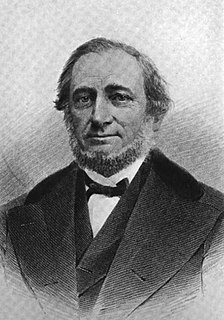
James William Beekman was an arts patron and politician from New York who served as the vice president of the New York Hospital. He was a member of the prominent Beekman family.
Beekman Place is a small street located in the Turtle Bay neighborhood on the East Side of Manhattan, New York City. Running from north to south for two blocks, the street is situated between the eastern end of 51st Street and Mitchell Place, where it ends at a retaining wall above 49th Street, overlooking the glass apartment towers at 860 and 870 United Nations Plaza, just north of the headquarters of the United Nations. "Beekman Place" also refers to the small residential enclave that surrounds the street itself. It is named after the Beekman family, who were influential in New York City's development.

The William H. Copeland House is a home located in the Chicago suburb of Oak Park, Illinois, United States. In 1909 the home underwent a remodeling designed by famous American architect Frank Lloyd Wright. The original Italianate home was built in the 1870s. Dr. William H. Copeland commissioned Wright for the remodel and Wright's original vision of the project proposed a three-story Prairie house. That version was rejected and the result was the more subdued, less severely Prairie, William H. Copeland House. On the exterior the most significant alteration by Wright was the addition of a low-pitched hip roof. The house has been listed as a contributing property to a U.S. Registered Historic District since 1973.

The Francis J. Woolley House is located in Oak Park, Illinois, United States, a Chicago suburb. The house was designed by American architect Frank Lloyd Wright in 1893. The Queen Anne style home is reflective of Wright's early designs for lower-cost, more affordable housing. The Woolley House is similar to the trio of homes in Oak Park that are widely known as the "bootleg houses." The design is heavily influenced by Wright's first teacher, Joseph Silsbee, and the Arts and Crafts movement. The house is listed as a contributing property to a local and federal historic district.

The U.S. Post Office in Rhinebeck, New York serves the 12572 ZIP Code. It is located on Mill Street just south of the intersection with NY 308 at the center of the village.

Beekman Meeting House and Friends' Cemetery is located on Emans Road in LaGrangeville, New York, United States. The meeting house is a wooden building from the early 19th century that has been unused and vacant for decades. As a result, it is in an advanced state of decay, and mostly collapsed. The cemetery, better preserved, is located a short distance away.

The Architecture of Buffalo, New York, particularly the buildings constructed between the American Civil War and the Great Depression, is said to have created a new, distinctly American form of architecture and to have influenced design throughout the world.

Peter A. Hilton House is a historic home located at Beekman Corners in Schoharie County, New York. It was built about 1799 is a 2+1⁄2-story, five-bay, gable-roofed brick residence in the Federal style. A gable-roofed, 1+1⁄2-story brick kitchen wing projects from the rear. Also on the property is a Dutch barn, horse barn, and pig / sheep barn.

Nut Grove, also known as the William Walsh House, is a historic house located on McCarty Avenue in Albany, New York, United States. It is a brick building originally designed in the Greek Revival architectural style by architect Alexander Jackson Davis in the mid-19th century. In 1974 it was listed on the National Register of Historic Places.

Rokeby, also known as La Bergerie, is a historic estate and federally recognized historic district located at Barrytown in Dutchess County, New York, United States. It includes seven contributing buildings and one contributing structure.
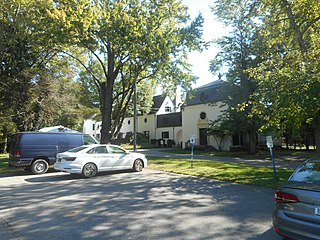
Benjamin Moore Estate, also known as Chelsea, is a historic estate located at Muttontown in Nassau County, New York. It was designed in 1923–1924 by architect William Adams Delano (1874–1960) for Benjamin Moore and Alexandra Emery. The manor house is an eclectic Chinese and French Renaissance style inspired dwelling. It is "U" shaped, two and one half stories high with hipped and gable roofs, covered with concrete block on a concrete foundation. The front facade features a steeply pitched roof, four large irregularly spaced chimneys, and a large brick tourelle with a conical roof. The property also has a contributing formal garden, gatehouse, picturesque roadways, garage, conservatory, octagonal gazebo, shed and tool house, and large open lawns.

9 Locust Place is a historic house located at the address of the same name in Sea Cliff, Nassau County, New York.

House at 240 Sea Cliff Avenue is a historic home located at Sea Cliff in Nassau County, New York. It was built in 1888 and is an irregularly shaped, 2+1⁄2-story house with a multiple cross-gabled roof in the Late Victorian style. The 2+1⁄2-story, gable-roofed east wing was added in 1908. It features a 3-story central tower with a tent roof.
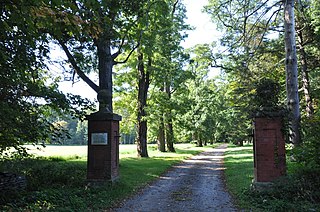
Grasmere is a national historic district and estate located at Rhinebeck, Dutchess County, New York. It was built by Janet Livingston Montgomery, widow of General Richard Montgomery.

The Steinway Mansion is a home on a one-acre hilltop in the Astoria section of Queens, New York City. It was built in 1858, originally on 440 acres (1.8 km2) on the Long Island Sound, by Benjamin Pike Jr., born in 1809, a noted manufacturer of scientific instruments located in lower Manhattan. After his death in 1864, his widow sold the mansion to William Steinway of Steinway & Sons in 1870. Jack Halberian purchased the Mansion in 1926 and upon his death in 1976, his son Michael Halberian began an extensive restoration. The house had been for sale since his death in 2010.
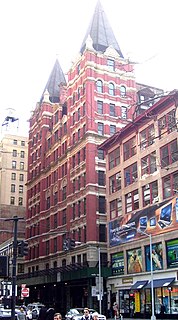
5 Beekman Street, also known as the Beekman Hotel and Residences, is a building in the Financial District of Manhattan in New York City. It is composed of the interconnected 10-story, 150-foot-tall (46 m) Temple Court Building and Annex and a 51-story, 687-foot-tall (209 m) condominium tower called the Beekman Residences, which contains 68 residential units. The 287-unit Beekman Hotel is split between all three structures.
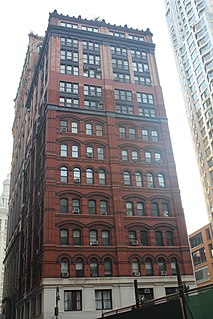
The Morse Building, also known as the Nassau–Beekman Building and 140 Nassau Street, is a residential building in the Financial District of Manhattan in New York City, at the northeast corner of Nassau and Beekman Streets. The Morse Building, designed by Benjamin Silliman Jr. and James M. Farnsworth, contains elements of the Victorian Gothic, Neo-Grec, and Rundbogenstil style.

The William H. Davenport House, also known as the Davenport-Curtis House, is a single-family home located at 300 East Michigan Avenue in Saline, Michigan. It was listed on the National Register of Historic Places in 1975.




















